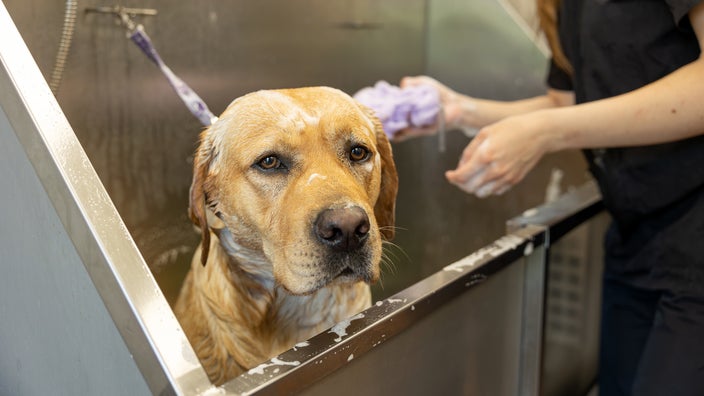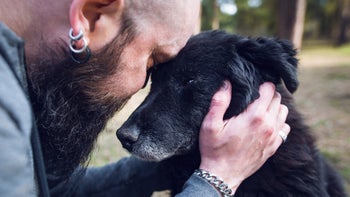
Trazodone for Dogs: A Medication to Help With Situational Anxiety
Key takeaways:
Trazodone is an antidepressant medication that is commonly used for anxiety-related behavioral problems in dogs.
Trazodone works best for dogs who have anxiety about specific situations, such as groomer or veterinary anxiety, and for sedation after surgery.
Trazodone is considered safe for dogs, but it can lead to side effects such as sleepiness and squinty, watering eyes.
Table of contents

Some dogs are more anxious than others. Whether they’re anxious about being alone, riding in a car, or hearing loud noises, you don’t want them to suffer. A dog’s anxious behavior can also be stressful and embarrassing for owners who don’t know how to help.
Fortunately, there are several safe and effective medications that can help. One that’s often prescribed for dogs with specific fears is called trazodone. It can reduce situational anxiety in dogs. Read on to learn more.
Trazodone for dogs at a glance
Common name | Trazodone |
What it treats | Situational anxiety, separation anxiety |
How it comes (forms) | Tablet |
Common side effects | Sleepiness, sedation, squinty and slightly watery eyes, nausea |
Dosage | 11-15 mg per pound of a dog’s weight |
Average cost | $4-$15 for 30 tablets (50 mg) |

What is trazodone for dogs, and how does it work?
Trazodone is an antidepressant medication that is commonly used for anxiety-related behavioral issues in dogs. It works by increasing the amount of serotonin available in a dog’s brain. Serotonin is associated with mood, and increased serotonin levels can reduce anxiety.
Save on the top 10 pet medications
Save big on common pet medications like Fluoxetine and Levetiracetam at your local pharmacy.

GoodRx is NOT insurance. GoodRx Health information and resources are reviewed by our editorial staff with medical and healthcare policy and pricing experience. See our editorial policy for more detail. We also provide access to services offered by GoodRx and our partners when we think these services might be useful to our visitors. We may receive compensation when a user decides to leverage these services, but making them available does not influence the medical content our editorial staff provides.
Trazodone use in dogs is considered off-label in veterinary medicine. This means that the medication is not FDA-approved for use in dogs and cats. Trazodone, however, is considered safe for dogs and is widely prescribed by veterinarians for anxiety.
What is trazodone used for in dogs?
Trazodone is helpful for dogs who experience situational anxiety. It can ease anxiety and help calm dogs in situations when they would otherwise be overly anxious.
Trazodone may help dogs with anxiety related to things such as:
Trazodone can be prescribed for dogs alongside training to reduce unwanted behaviors related to separation anxiety. It can also be prescribed to help dogs stay quiet after surgery or help older dogs who are anxious or having trouble sleeping at night.
Trazodone is also prescribed for hospitalized dogs to help them stay calm and relaxed.
What is the typical trazodone dosage for dogs, and how is it given?
The standard dosage of trazodone for dogs will vary widely based on your dog’s weight and why they take the medication. Trazodone is given as a tablet by mouth.
Calm your canine: From massage to music, these five tips will help you manage your dog’s energy.
Jumpy puppers: Not sure if your dog is energetic or stressed out? Find out by reading about these 18 anxiety symptoms in dogs.
Another stress med: Learn about gabapentin, a medication that’s used in dogs to treat pain and anxiety.
When trazodone is used before a stressful situation, the most common dosage is 11 mg to 15 mg per pound of body weight, given at least 1 hour before the event.
About 1 hour after trazodone is given, most dogs will experience short-term anxiety relief. But the medication can take up to 3 hours to start working. Trazodone will stay in most healthy dogs’ systems for 6 to 12 hours. Dogs with liver disease or kidney disease may take longer to clear trazodone from their system.
Your veterinarian will prescribe the appropriate amount for your dog. Always follow label instructions closely. If you aren’t noticing results, ask your veterinarian about increasing the dosage.
Read more like this
Explore these related articles, suggested for readers like you.
If your dog gets an upset stomach when they take trazodone, give each tablet with a small meal or treat.
What should you do if your dog misses a dose of trazodone?
If your dog misses a dose of trazodone, give the next dose as soon as possible. If it’s close to when the next dose is due, skip the missed dose and give the next dose at the regularly scheduled time. Never give two doses of trazodone close together (less than 6 hours apart).
What are the common side effects of trazodone in dogs?
If trazodone is doing its job, then your dog will be relaxed. This is technically a side effect, but it’s what you want. Trazodone can cause other side effects in dogs, including:
Sleepiness
Sedation
Squinty, slightly watery eyes
Nausea
Hyperactivity instead of sleepiness
Veterinarians may prescribe a lower dosage of trazodone to start to see how your dog does on the medication before increasing the dosage.
What are the most serious risks of trazodone for dogs?
Trazodone is well tolerated by most dogs and is considered safe. But some more serious reactions have been reported, including:
If you notice any of these effects, call your veterinarian for advice. Any negative reactions should be temporary, lasting only until the medication has left your dog’s system.
In addition, caution should be taken when using trazodone in dogs who:
Are nursing or pregnant
Have glaucoma
Have heart, liver, or kidney disease
Does trazodone interact with other dog medications?
Trazodone can interact with other medications your dog may take, including:
Nonsteroidal anti-inflammatory drugs (NSAIDs)
Monoamine oxidase inhibitors
Antidepressant medications
Azole antifungals, such as ketoconazole or itraconazole
Phenothiazines, such as chlorpromazine
Cisapride
Metoclopramide
Macrolide antibiotics, such as erythromycin
Fluoroquinolone antibiotics
Other sedatives
If your dog takes any of these medications, tell your veterinarian before your dog is prescribed trazodone.
Frequently asked questions
Trazodone takes 1 to 3 hours to start working in dogs. It typically lasts 6 to 12 hours in healthy dogs and longer in animals with liver or kidney disease.
Both gabapentin and trazodone work well for dogs. Trazodone is an anxiolytic that’s used to calm anxiety in dogs, while gabapentin is an anti-seizure medication that’s prescribed for pain and anxiety in canines. Both medications can be used at the same time.
No. Trazodone is not prescribed for pain in dogs. It’s an anxiety medication used to help dogs manage stressful situations, such as vet visits, fireworks, and thunderstorms.
Trazodone for dogs is the same medication that humans use. But you shouldn’t give your dog a prescription that was filled for you. Only give your dog medications prescribed by your veterinarian.
The bottom line
Trazodone can be used to manage anxiety and stress in dogs who fear specific things, such as loud noises or veterinarian visits. Dogs usually take the medication as a pill about 90 minutes before a stressful event. Trazodone is considered safe and effective for dogs. It takes 1 to 3 hours to kick in. At the right dosage, the effects can last up to 12 hours. If your dog struggles with anxiety-related behavioral problems, ask your veterinarian about trazodone along with behavioral modification to reduce anxiety.
Why trust our experts?



References
Brooks, W. (2025). Trazodone HCL. Veterinary Partner.
Budde, J. A., et al. (2023). Trazodone. Plumb’s Veterinary Drug Handbook, 10th Edition. Wiley-Blackwell.
Erickson, A., et al. (2021). A review of pre-appointment medications to reduce fear and anxiety in dogs and cats at veterinary visits. The Canadian Veterinary Journal.
Foss, R. (2017). Trazodone in veterinary medicine. Today’s Veterinary Nurse.
Herron, M. (2019). Reducing patient stress through chemistry. World Small Animal Veterinary Association Congress Proceedings.
Sueda, K. L. C., et al. (2016). Trazodone. Plumb’s Therapeutics Brief.


























